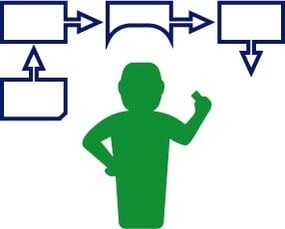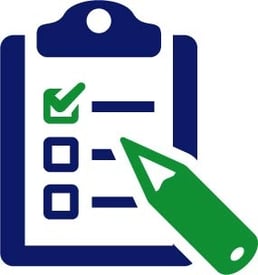3 min read
Three Critical Details For Incorporating a Speech Solution into a "Lean" Lab
 Ross Weinstein
Monday July 17, 2017
Ross Weinstein
Monday July 17, 2017

The "Lean" movement began as a management philosophy for manufacturing companies to increase consistency, remove unnecessary steps, and eliminate waste. Although Lean was originally intended to improve industrialized product development, it is now heavily applied to service industries and healthcare, including surgical pathology labs. The goal of implementing Lean practices in a lab is to make significant cuts in expenses while improving patient safety and the satisfaction of referring physicians. This is done by creating efficiency that drives quicker and higher quality outcomes.
Often times, companies believe that investing in a new technology will lead to vast efficiency improvement. The reality is that unless carefully planned and incorporated into a Lean process, the results can be a mixed bag. In this blog I will attempt to point out a few of the many things that should be considered when implementing speech recognition based reporting solutions as part of a Lean laboratory strategy.

1. Get out your Process Map (or create one)
One of the first steps in implementing a solution is to have a deep understanding of your current process. The days of buying new and cool technologies and assuming they can be incorporated into YOUR unique and complex processes are over. Most AP reporting Systems and transcription workflows were not designed with speech recognition integration in mind. In order to know what changes will be necessary, you will need to understand what is currently done; what is its purpose and how does it impact the overall process?
A process map does just that. It tells you all of the factors that contribute to potential specimen imbalance and bottlenecks and it lets you know how a real time speech based solution can impact these bottlenecks versus traditional transcription processes. It helps you identify who will be impacted, what buy-in you need, and the other complimentary processes that need attention in order to generate maximum success.
In the longer term this step will also be critical since Lean requires you to measure your outcomes versus your original baseline.

2. Cultural Commitment to Improve Efficiency and Quality
Replacing a current transcription solution is typically not met with a sense of urgency by Pathologists and Pathologist Assistants unless it is accompanied by some crisis (for instance June's cyber attack). When these changes occur, however, these professionals are the ones asked to buy-in to the promise of future efficiency at the expense of making substantial changes to how they work. So how do we bridge this gap?
The best Lean cultures create these feelings of urgency by being transparent, involving users in the process, and demonstrating organizational commitment to change and continuous efficiency improvement over time. Leadership communication and involvement are the key. The status quo is rarely a good long-term strategy and leaders must constantly reinforce that the organization can only survive and thrive by finding new and better ways to create high quality diagnostic reports in the fastest possible time.
For more information on change management, see our blog: 4 Tips to Make Your Next Lab Initiative Stick.

3. Standardization and Consistency
Finally, the principles of Lean do not work well when everyone is allowed to choose the method or sequence in which to do the job; quality suffers, and productivity drops. This reduces throughput and leads to unanticipated bottlenecks. I am always surprised when I hear about laboratories trying speech technology products like Dragon or M*Modal in order to improve laboratory efficiency because these products inherently require other tools to standardize their use and produce consistent reporting results. In order to save time and improve accuracy versus traditional transcription processes, workflow and integration must be standardized.
Three primary tools that are required to achieve this are:
AP System-specific voice navigation commands
Remember, underlying AP systems were not designed with speech recognition input in mind. Each screen and data entry point differs depending upon what system you are using and, in many cases, within the underlying systems themselves. In order to ensure consistent use, voice commands are created that carefully walk you through the steps necessary to navigate the various input areas of each system.
A standardized template library
Similarly, in order to standardize diagnostic report readability and content standards a library of specimen specific templates is required. These templates not only insure that all users create reports that look and feel professional and complete, but they also simplify the reporting process and eliminate recognition errors by limiting dictation to only items that may vary from case type to case type.
For example, if a template contains 500 words and 95 percent of the words are already included in the template, then only 25 words need to be dictated. If accuracy rates for programs like Dragon in pathology are 98 percent, then this would mean there is only a 50 percent chance that your report may have a SINGLE WORD to be edited. If the template is synoptic and relies on discrete data, then this number is decreased even more dramatically. By comparison, if you had to dictate all 500 words, you are looking at editing ten words in EVERY report! If you dictated ten of these reports, that means you would have had to edit as many as 100 words compared to just five. In this scenario, a templated solution is 2000 percent more efficient than dictating by using speech recognition alone. The necessity should be obvious.
Microphone and input devices that are designed to function reliably in the environment they are being deployed
Lastly, in order for speech recognition software to accurately recognize your words, devices must be provided that adjust to the various background noises and hands free requirements of different environments. Hands-free devices like foot pedals can assist with turning microphones on and off and they provide a consistent means to advance through field-by-field template entry.
In summary: everybody wants to be more efficient, and exciting technologies like speech recognition software certainly appeal to those motivated to improving laboratory efficiency. If you fully understand where you are coming from and what you want to achieve, you are more likely to see success. Just remember to plan carefully and understand what other tools and changes are required to achieve your desired efficiency goals.


